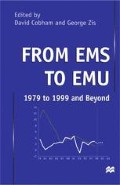Abstract
What is the proper role of an economist in a debate about such a politically charged decision as that of the potential entry of the UK into EMU? Fortunately economics itself provides a discipline-neutral framework of analysis in the form of the cost-benefit approach. That approach allows ‘non-economic’ factors to be admitted. If, as many probably think, the balance of purely economic factors is negative or uncertain, it may still be quite reasonable to see positive political benefits justifying entry. It still remains important to examine the economic factors carefully and to think of ways in which costs can be minimised.
Access this chapter
Tax calculation will be finalised at checkout
Purchases are for personal use only
Preview
Unable to display preview. Download preview PDF.
References
Artis, M. J. and Zhang, W. (1997) ‘International business cycles and the ERM: is there a European business cycle?’, International Journal of Finance and Economics, 2: 1–16.
Artis, M. J. and Zhang, W. (1998a) ‘Core and periphery in EMU: a cluster analysis’, EUI working papers, RSC No. 98/37.
Artis, M. J. and Zhang, W. (1998b) ‘Membership of EMU: a fuzzy clustering analysis of alternative criteria’, EUI working papers, RSC No. 98/52.
Artis, M. J. and Zhang, W. (1999) ‘Further evidence on international business cycles and the ERM: is there a European business cycle?’, Oxford Economic Papers, January, 51, 120–32.
Bayoumi, T. and Eichengreen, B. (1993) ‘Shocking aspects of European Monetary Integration’, in Torres, F. and Giavazzi, F. (eds) Adjustment and Growth in the European Monetary Union, Cambridge: Cambridge University Press.
Bayoumi, T. and Eichengreen, B. (1996) ‘Operationalising the theory of Optimal Currency Areas’, CEPR Discussion Paper, No. 1484.
Bayoumi, T. and Eichengreen, B. (1997) ‘Even closer to heaven? An optimum-currency-area index for European countries’, European Economic Review, 41: 761–70.
Canzoneri, M., Vinals, J. and Valles, J. (1996) ‘Do exchange rates move to address international macroeconomic imbalances?’ CEPR Discussion Paper, No. 1498.
Dornbusch, R., Favero, C. and Giavazzi, F. (1998) ‘Immediate challenges for the European Central Bank’, Economic Policy, 26, April: 15–64.
Erkel-Rousse, H. and Mélitz, J. (1995) ‘New empirical evidence of the costs of European monetary union’, CEPR Discussion Paper, No. 1169.
Fontagné, L. and Freudenberg, M. (1998) ‘Endogenous (a)symmetric shocks in the Monetary Union’, mimeo, CEPII.
Frankel, J. and Rose, A. (1997) ‘Is EMU more justifiable ex-post than ex-ante?’ European Economic Review, 41: 753–60.
Frankel, J. and Rose, A. (1998) ‘The endogeneity of the optimum currency area criteria’, Economic Journal, July, 108(449): 1009–25.
HM Treasury (1997) ‘UK membership of the single currency — an assessment of the Five Economic Tests’, October.
House of Commons Select Committee on the Treasury and Civil Service (1998) ‘Report on preparations for Stage Three of Economic and Monetary Union’, vols I–III, April.
Imbs, J. (1998) ‘Fluctuations, bilateral trade and the exchange rate regime’, mimeo, University of Lausanne, November.
Kenen, P. B. (1969) ‘The theory of optimum currency areas: an eclectic view’, in Mundell, R. A. and Swoboda, A. (eds) Problems of the International Economy, Cambridge: Cambridge University Press.
Krugman, P. (1990). ‘Policy problems of a monetary union,’ in De Grauwe, P. and Papademos, L. (eds) The European Monetary System in the 1990s. London: Longman, pp. 48–64.
McKinnon, R. I. (1963) ‘Optimum currency areas’, American Economic Review, 53 (September) 717–25.
Moggridge, D. E. (1972) British Monetary Policy 1924–31, Cambridge: Cambridge University Press.
Mundell, R. A. (1961) ‘A theory of optimum currency areas’, American Economic Review, 51 (September): 657–65.
Prati, A. and Schinasi, G. (1998) ‘Financial stability in EMU’, IMF Working Papers (forthcoming).
Talani, L. (1998) ‘Interests or expectations? The problem of credibility of the exchange rate policy: an international political economy approach. The cases of Italy and the UK and the departure from the ERM of the EMS’, PhD thesis, European University Institute, June.
Taylor, C. (1995) ‘EMU 2000? Prospects for European Monetary Union’, Chatham House Paper, 1995.
Young, H. (1998) This Blessed Plot: Britain and Europe from Churchill to Blair, Basingstoke: Macmillan.
Editor information
Editors and Affiliations
Copyright information
© 1999 Michael Artis
About this chapter
Cite this chapter
Artis, M. (1999). The UK and EMU. In: Cobham, D., Zis, G. (eds) From EMS to EMU: 1979 to 1999 and Beyond. Palgrave Macmillan, London. https://doi.org/10.1007/978-1-349-27745-2_10
Download citation
DOI: https://doi.org/10.1007/978-1-349-27745-2_10
Publisher Name: Palgrave Macmillan, London
Print ISBN: 978-1-349-27747-6
Online ISBN: 978-1-349-27745-2
eBook Packages: Palgrave Business & Management CollectionBusiness and Management (R0)

